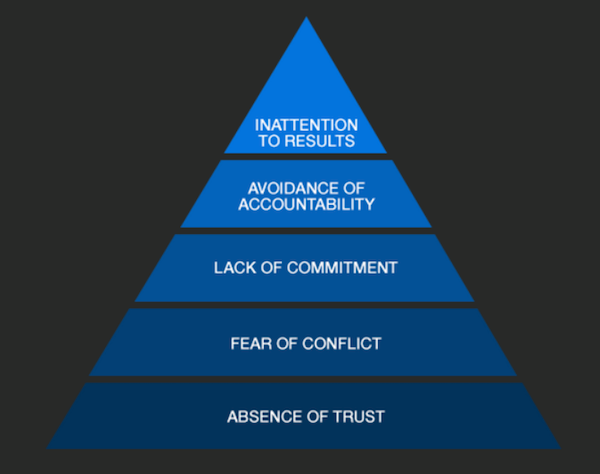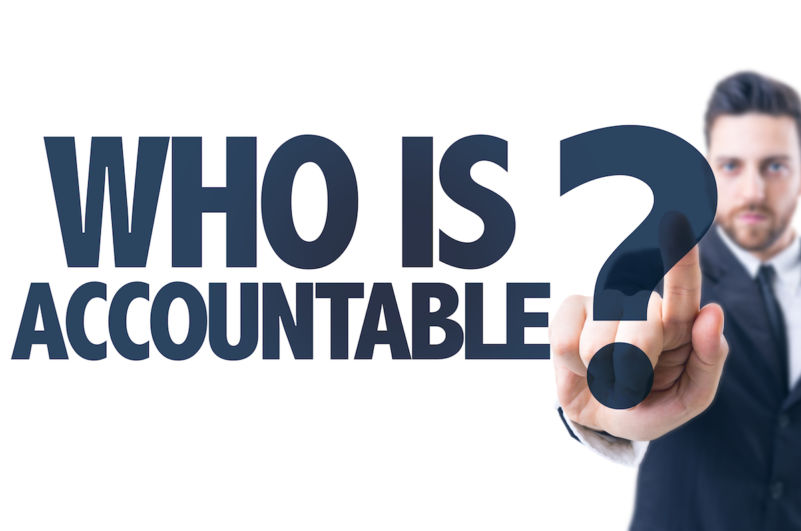Imagine this. Your team has been working on a significant project for months. But unfortunately, they’ve failed spectacularly to hit the goals you set. You gather them all together to talk about why. What do you think they’d say?
Some teams will be defensive and start pointing fingers. So and so didn’t give them what they needed in time. The timescales were too tight. They didn’t have the right resources.
Others might be more honest. Each team member might admit their role in things going wrong. They might look at what they’d learned and how they would approach it differently next time.
Which team would you prefer to manage? It’s a no-brainer – the second. But if you recognise the behaviour in the first example, it’s a clear indication that you need to work on accountability in your business. So how do you do this?
1. Look in the mirror
This may sound harsh, but you must be honest about modelling accountability to others. As CEO, you cast a long shadow, and your company will never outperform its leadership team. In our experience, Executive teams are not often good at holding each other to account.
Do the problems with accountability stem from your own behaviour? Often, we find our CEO clients have similar strengths. Using EOS language, they’re usually ‘Visionaries’ and ‘Integrators’. This means they’re great at telling a story, getting people excited and leading from the front. But accountability and process aren’t really their thing.
You are who you are. But if you believe accountability is essential, you must put the systems, processes and people in place to ensure you get the results you seek. And you won’t fix the problem until you recognise that you may be part of it.
2. Start with talent assessment
Before you do anything, you need to work out if you have the right people. There’s no point solving a problem if the underlying foundations aren’t strong.
Take a long, hard look at your Executive Team. Are they A, B or C Players (the definition of an A-Player being the top 10% of available talent for a given job, salary and location.) Would you enthusiastically re-hire them all tomorrow? If not, and there are weak links in your top team, this needs sorting – quickly. Have that difficult conversation that you’ve been putting off.
Typically, when clients first come to us, they have 20 – 30% A-Players in their business. We work with them to increase this to 50% or more, and immediately, the metabolic rate of their business goes up. It’s so satisfying to see. Everything feels easier with less effort to pick up the pace. If we asked you, ‘What’s the difference between a B-Player performing adequately and an A-Player,’ what would you say? We bet you would respond that the A-Player needs little management intervention. Accountability is high with these people, and when they say they’ll do something, they just get on and do it. This is what you want to maximise.
Sometimes your talent assessment will identify people who are in the wrong job and aren’t playing to their strengths. Their values and cultural fit are good, but action is needed to bring them up to A-Player standard. By working through every staff member, you’ll have a much more accurate picture of the capabilities of your business.
3. Work on Trust

Are you aware of Patrick Lencioni’s pyramid in ‘Five Dysfunctions of a Team’? It’s a valuable exercise if you’ve got accountability issues and one we frequently use with our clients. Lencioni identified why organisations do not get the results they’d like or feel are due to them. At the top of the pyramid is inattention to results which is built on avoidance of accountability. This, in turn, is due to a lack of commitment due to a fear of conflict. But the very foundation of the whole pyramid is the absence of trust.
Do this work in your Executive Team first. You need to make sure there’s enough trust and conflict to make commitments and hold each other accountable. Only then will you get results. Maybe there’s one person in the team that people don’t trust, but they know that if they are pinned down, they’ll get aggressive or angry. As CEO, you need to get involved in this. Get that person to commit to something and ask them to report back on progress every week. You’ll hear, ‘Isn’t this micromanaging? Don’t you trust me to deliver?’ and similar protests. But make it clear that transparent tracking needs to be in place across the whole team.
4. Build your constructive feedback muscle
If you struggle with giving feedback, you’re not alone. Many of the CEOs we coach find this problematic. There’s a natural reluctance to ‘go there’ and confront performance issues in their team. How about receiving feedback from others? Is that just as bad? Maybe it’s because these conversations are uncomfortable, or there’s insufficient psychological safety in the team for an open, frank discussion. Either way, this issue will hamper progress – both yours and your team’s. So it needs to be fixed.
When someone consistently under-delivers, you have to confront it openly and honestly. Otherwise, a sense of unfairness will creep in, particularly if other team members are pulling their weight. Everyone needs to realise that by being open and honest with feedback you’re trying to support others to become better. It’s not a way of making them feel bad or pointing out their failures just for the hell of it. The habit of saying nothing starts early. We’re told from a young age: “If you have nothing nice to say, say nothing.” We need to unlearn this lesson to help us help each other.
5. Allocate accountability for key functions and processes
As part of our two-day kick-off with new clients, we work through the Function Accountability Chart, a Scaling Up Growth tool. All business areas are listed – Marketing, Sales, HR, IT, Learning and Development, Finance, Head of Company, Customer Satisfaction – and a set of terms agreed. The aim is to ensure one name has overall accountability for each area. Some names will appear in more than one box. This stimulates productive conversation around the things that are important to customers and staff and who are accountable for these things. We work through the things that cause the most friction in the business and make sure they’re allocated.
Maybe there’s someone whose job title is Sales & Marketing Director. That’s two functions, so accountability needs to be split. And in fact, Marketing might be further divided into inbound, outbound, referrals and partner. But what’s Marketing’s job? Generation of leads. And who is going to own this? Let’s say, Frank. OK – so what are Frank’s leading indicators for the generation of leads? Suddenly, you stop reporting and start focusing on what Frank’s going to do now that will guarantee success in the future. Frank begins to track the activity that will drive outcomes on a daily and weekly basis. And because of this consistency and clarity, Frank becomes accountable for his results.
It’s important not to forget accountability for cross-functional areas of the business too. Remember, your customer experience is never better than how your internal teams serve each other. We often ask teams, ‘How do you rate yourselves in terms of internal service levels?’ and they’ll say, ‘9 out of 10.’ Then we ask them how they’d rate other teams, and they say, ‘7 out of 10.’ You need to get rid of this gap. Because as your customer goes from silo to silo you destroy experience.
6. Set clear objectives

To build accountability in your organisation, you must have clear objectives. You’re focusing on the future. Where do you want to get to? What’s your BHAG and your 1-year goal? And what’s the next 90-day sprint? Get all of this crystal clear, and then set some OKRs. Who is going to own these? Who has accountability if they fail? Agree before you start what good looks like and what the outcome will be when they’re completed. This will avoid anyone wriggling off the hook later.
There’s a characteristic with OKRs that we particularly like. You can decide on different types. A committed OKR might be a sales number. But there are also aspirational and learning OKRs. Maybe you suspect that an accountability issue is stemming from a fear of failure. Someone’s scared, and this is driving a desire not to get caught doing the wrong thing. So, bring in the concept of an aspirational OKR. Tell them that the company is going to have a go at this OKR. The goal is 100, but if they only get to 70, it’s still a success. Or maybe it’s a learning OKR – something that you’ve never done before. Agree your working hypothesis but accept as a team that it might be completely wrong. That’s OK too. Because at least you had a good go and tried. This can be liberating for your team – try it!
7. Encourage people to set their own goals
Research shows that if staff are involved in setting their own goals, they’re much more likely to be accountable for them. There’s an emotional attachment which means they will strive to achieve them.
We see the opposite of this in organisations that are struggling to grow. The sales goal is what the sales team needs to deliver so that the cost base is correct. This happened when I was a rep, working at Meditel. Finance came up with the sales target. It seemed random and unconnected to any of the activities we’d done over the previous year. We were losing before we’d even started. The excuses for poor performance came thick and fast. Was it any surprise that we ended up having to downsize the company from 220 staff to 99?
Sometimes, you need to confront the brutal truth. In any organisation where I’ve been Sales Director, we’ve decided on an achievable goal. And then agreed to lose money. Or culled the cost base to meet the target that they can achieve. If you don’t do this, you end up in a cycle of achieving 75% of target and cutting staff over and over again. It’s a miserable downward spiral of loss. If you’d cut harder at the beginning and confronted the brutal truth, you’d be in a better position now.
Written by business coach and leadership coaching expert Dominic Monkhouse. Contact him to schedule a call here. You can order your free copy of his book, Mind Your F**king Business here.

